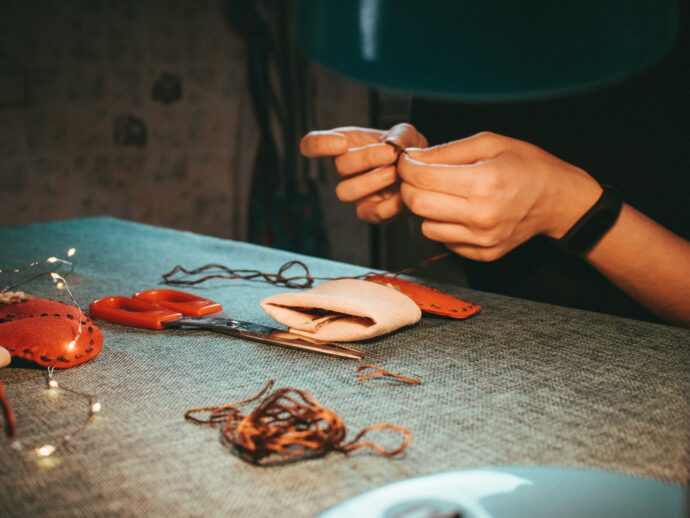
Sure, cheer abounds, but so does overindulgence, hyperconsumerism, waste, and financial debt. Amidst the colourful, bright lights that speckle the streets is the cold, hard truth so few North Americans are willing to accept: the holidays are problematic.
This year, you can continue to celebrate the modern Western way, lining the pockets of billionaires and spending your hard-earned dollars on impersonal, overly packaged goods. Or you can try something a bit more counter-culture—something humans have been doing since the dawn of civilization.
The birth of trade
Trade and barter culture is said to have started in 6000 BC with the Mesopotamians and later the Phoenicians, who exchanged goods or services for other goods or services such as food, spices, salt, clothing, weapons, or tea.
Before the invention of money, barter culture was standard practice; after it was used alongside money, especially during times of struggle such as the Great Depression. However, in the last half-dozen decades or so—in the developed world at least—trade and barter culture has taken a back seat to consumer culture.
According to American historian Lizabeth Cohen, following the Second World War, citizens were encouraged to buy, buy, buy. The message they were fed was that mass consumption was not a personal indulgence, but rather “a civic responsibility to improve the living standards of all Americans … creating more well-paying jobs and in turn more affluent consumers capable of stoking the economy with their purchases.”
In other words, if you don’t consume, you’re unpatriotic. Of course, Canada isn’t the United States, but it would be irresponsible not to acknowledge that Canada, too, has a problem with mass consumption.
Modernization of trade
In recent years, we’ve seen a shift toward homesteading and ancestral skill building such as preserving and beekeeping—as though people are course-correcting in the wake of climate change and a massive shift toward technology reliance. It makes perfect sense that we’re also seeing a re-emergence of trade and barter culture.
Ayaz Virani is the head of marketing at Bunz, a growing trading community and supporting mobile app. According to Virani, the Bunz community is now 400,000 users strong worldwide, and growing. What began as a modest Facebook group in Kensington Market, Toronto, is now a thriving network of eco-activists, rare finds enthusiasts, plant collectors, ex-shopaholics, and many more.
Bunz is a modern spin on an ancient practice, using technology to facilitate offline transactional experiences. “We always talk about how you don’t really know your neighbour,” says Virani. “Bunz helps you know your neighbour and the people in your city and around you.”
The organization doubled down on this idea in August 2018 when it launched its own form of digital currency, BTZ (pronounced “bits”). BTZ can be used in lieu of a physical trade or at participating coffee shops and food vendors that accept BTZ as part of Bunz’s Shop Local program.
The difference between BTZ and cryptocurrencies is that it cannot be bought—the only way to acquire BTZ is by engaging in the community, such as by posting trades, making trades, or answering surveys within the app. This not only encourages engagement, but it also acts as an equalizer so as not to favour the super-wealthy.
By bringing local businesses onto the platform and integrating BTZ, Virani says Bunz has taken a huge step toward “sorting out a way to create sustainable communities.”
The many benefits of trade
Beyond acquiring new-to-you items and offloading things you no longer have a need for, there are other benefits associated with trade and barter culture. In an increasingly digital world and economy, trading encourages face-to-face communication, diverts goods from entering the landfill, and saves money. During the holiday season—when we see a rise in consumer debt, waste, and loneliness—engaging in trade and barter culture could pave the way for a stress-free holiday and new year.
Waste-free wrapping
Go “full green” this holiday season with these clever waste-free wrapping tips.
- Make the gift —a dish towel or T-shirt, for example—part of the wrapping by using the Japanese cloth-folding technique furoshiki.
- Save boxes, gift wrap, ribbons, string, and other decorative items throughout the year. Raid your stash come December, and don’t constrain yourself to standard Christmas colours and designs—let your creativity shine.
- Think outside the gift box. Visit local thrift stores and flea markets for non-traditional wrapping such as vintage tins, comic books, or posters
Spending ourselves sick
According to a 2018 report from PricewaterhouseCoopers (PwC), a global business consulting service, the average Canadian was projected to spend an average of $1,563 during the holiday season, up 3.7 percent from the previous year.
Manulife takes the analysis one step further in its 2018 holiday debt survey, which states that “more than 60 percent of those planning to spend are willing to go into debt to buy gifts.” And even more shocking is the statistic citing that one in four Canadians’ mental health is negatively affected during the holiday season.
Participating in trade and barter culture can reduce and even eliminate holiday spending, which in turn helps ease money-related stress and anxiety.
Waste not, want not
In terms of waste, advocacy group Zero Waste Canada estimates 545,000 tonnes is generated from gift wrap and shopping bags annually. And what’s found inside the wrapping–often new items purchased from big box retailers–could have been acquired second-hand, thereby reducing the number of consumer goods in circulation. This could further prevent new items, once gently used, from being donated or (worse yet) tossed.
As Virani puts it, “The most sustainable item is the one that already exists,” so trading for gifts is a powerful action that individuals can take to abstain from mass consumerist behaviours that contribute to our growing waste problem.
Trading loneliness for connection
It’s becoming increasingly clear that loneliness has a negative impact on our emotional and physical health. According to a 2017 Swiss national survey, loneliness was associated with increased rates of chronic illness, high cholesterol, diabetes, psychological distress, and depression.
We don’t need a survey to demonstrate how loneliness can be exacerbated during the holiday season, especially for those who—for one reason or another—won’t see their families. The trading community can help alleviate holiday-related loneliness by fostering human connection. In the Bunz community, for example, Virani has seen friendships and even marriages blossom thanks to a successful trade.
So, the next time you’re compelled to scroll your preferred social media channel, consider instead downloading the Bunz app and taking a peek at what’s being traded in your community. You might stumble upon the perfect gift for your vintage vinyl-loving cousin, and you might even make a friend or two along the way.
Trading etiquette 101
It can be intimidating trying out new things if you aren’t aware of the proper etiquette. According to Ayaz Virani of Bunz, when it comes to trading, you need only remember the following four rules:
- Be friendly, communicative, and responsive.
- Be honest about the quality of the items you’re trading and their worth.
- Show up to your trades at the agreed upon time and place.
- Follow standard texting etiquette: avoid ending direct statements in a period and use emojis to keep the mood light (but avoid the winky face emoji—it tends to read creepy).
What is the sharing economy?
Made popular by companies such as Evo, Modo, and Airbnb, the sharing economy refers to the shared acquisition and use of goods and services. It’s closely related to the circular economy, which according to the Ellen MacArthur Foundation aims to “design out waste and pollution, keep products and materials in use, and regenerate natural systems.” Methods of sharing may include trading, bartering, renting, lending, and gifting.
Amy Wood is an on-again-off-again meditator, part-time dancer, and amateur uke player. Catch her on Twitter @amy_would.




































